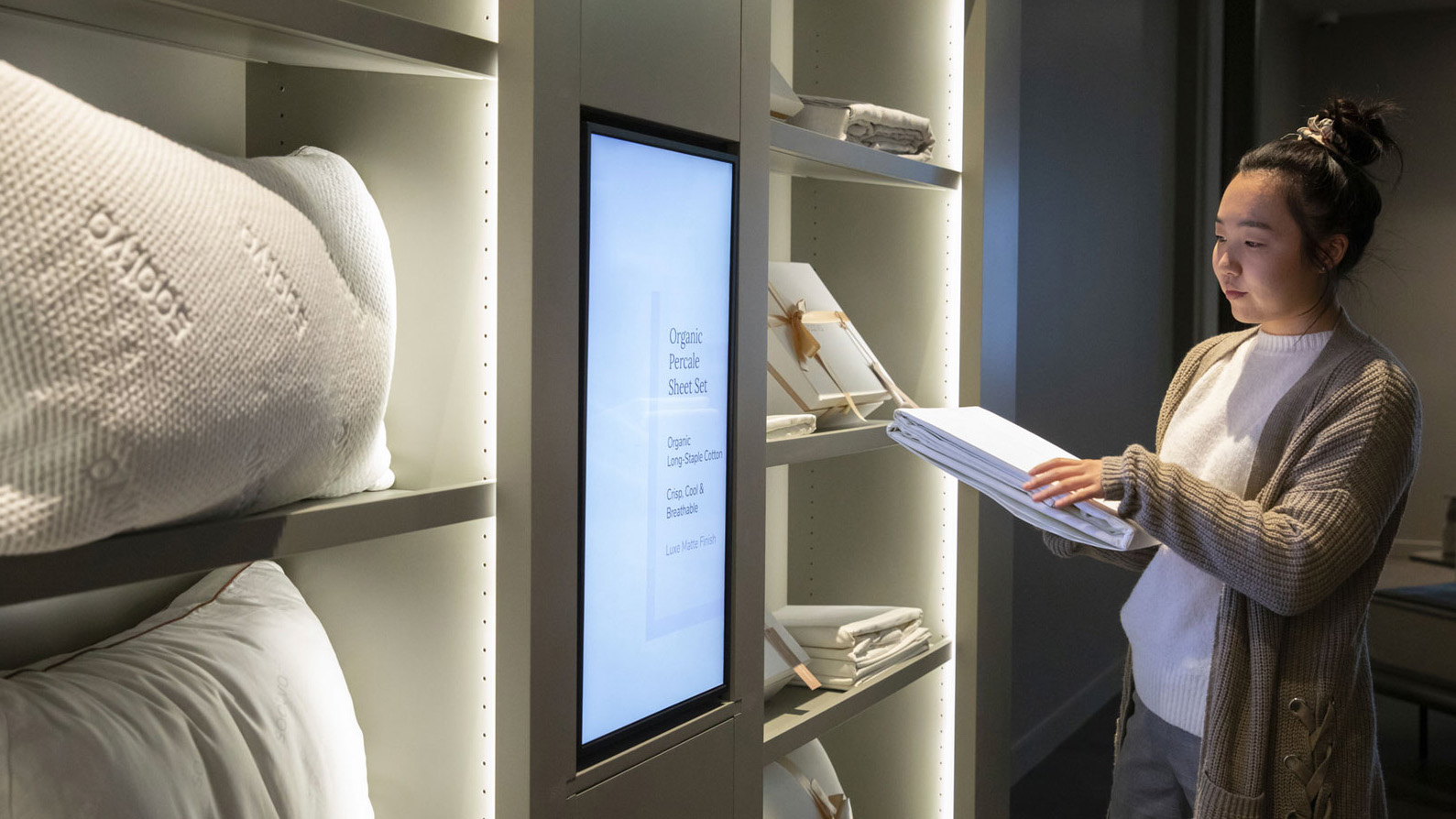Open for (Immersive) Business
Interactive displays deliver meaningful engagement in retail and quick service restaurants.

From surviving a global pandemic to adapting due to a growing reliance on online shopping and delivery services, in-person shopping and dining is looking very different than it once did. The same can also be said for the interactive technology found within brick-and-mortar retail and quick service restaurants (QSRs). Recent advancements in interactive displays are creating unique environments that are immersive, informative, and efficient, while providing additional in-store support and direction during a time of increased workforce shortages.
“Large format, interactive displays deliver an unparalleled experiential environment,” explained Darrin Brooks, senior director of sales, North America, for Prysm Systems. “Creating a unique brand experience is essential for capturing the attention of the customer and leaving a lasting impression.”

“Customers want to own their shopping experience and they’re looking at technology to help them do so,” added Parrish Chapman, director, enterprise retail sales key account, Samsung. “Displays reduce the friction points of shopping while also allowing retailers to showcase their products in a hyper-realistic way. This can create an immersive experience for the customer, ultimately leading to higher engagement and retention.”
[LG's Transparent OLED and Augmented Reality Combine to Elevate the Retail Experience]
For example, luxury mattress retailer Saatva created immersive viewing rooms within its brick-and-mortar locations, giving customers the ability to interact with their brand in an informative and sensory way. Using Samsung OMN-D and QBR displays, the viewing rooms allow customers to shop at their own pace while providing pertinent product information through interactive displays. These installs led to a growth in on-site sales that exceeded company expectations.
When looking at retail analytics data, it is proven that customers remember a more interactive experience—and it will influence their potential for return visits. Through interactive displays, retailers and QSRs can engage with consumers in an engaging yet meaningful way, helping differentiate themselves from other retailers and creating memorable experiences that will increase their long-term sales.

Jordan Feil, director of marketing with digital signage software company Navori Labs, tied this to the “lift and learn” concept. “A shopper looking for a new smartphone will remember the experience of new pricing and feature information dynamically appearing on a nearby video wall upon picking up a phone,” he explained. “They will not remember the experience of picking up a phone, looking at the device, putting it down, and moving on.”
A daily selection of the top stories for AV integrators, resellers and consultants. Sign up below.
Content-Aware Context
With businesses focusing on developing a more personalized shopping experience, many are relying on real data points and demographics when designing their interactive environments. Integrating cameras and sensors, retailers and QSRs can detect and collect demographic information like a client’s gender and age range, helping to deliver more context-aware and personalized content.
[PPDS Brings AI-driven Philips Digital Signage and Analytics Solutions to Retail]
“The food and beverage items that appear on a QSR menu board might be very different for a 28-year-old man than a 58-year-old woman,” Feil said. “There is no one-size-fits-all content strategy, and the ability to capture information about customers as they look at screens—and then use their analytics data to deliver the most relevant, meaningful content—will help businesses be more predictive and anticipate customer desires.”

When looking at context-aware content, the user’s CMS plays a pivotal role in matching content based on viewer demographics. “As analytics software interoperates with the CMS, data will be captured for the business to study,” said Chris Northrup, vice president of business development, digital signage solutions, USSI Global. “That further empowers the business to adjust and serve content based on demographics and other customer information.”
To have a better understanding of customer buying trends, FastSensor can be used to decide where it might be best to place interactive signage. FastSensor tracks physical foot traffic and turns that into actionable data, which can be studied to provide advanced analytics and allow clients to implement data-driven improvements within their spaces. “Through this technology, retailers can craft their brick-and-mortar stores to receive the most engagement,” Chapman explained.
Beyond Touchscreens
With touch capabilities now considered standard, considerable innovations are being seen through the use of voice or gesture, with faster processing speeds making things like capacitive sensing a reality. “We first saw capacitive sensing on smaller displays, but now see this capability built-in to larger displays,” said Northrup. “Today, there are also more overlays built into displays that provide many more touchpoints.”
[BrightSign Helps Power Perfume Shopping]
Purpose-built applications are also on the rise and can enable in-store engagement like “virtual try-on sessions” right on the sales floor. All the customer has to do is stand in place and watch as clothing items are displayed over their image, giving them a clear sense of how well the items look and pair with other items. AI computer vision technology is also being used to influence foot traffic, leading customers strategically to merchandise or parts of the store based on their demographics.

Prysm encourages companies to engage visitors with customer experience centers (CECs). According to Brooks, a CEC is meant to build and strengthen the relationship a brand has with its customers. “Today’s audience has a low tolerance for anything that doesn’t immediately grab their attention,” he offered. “By incorporating interactive displays, a CEC invites the customer into the experience rather than just being a bystander of the experience. That interactive experience deepens the customer’s relationship by uniting the brand with their personal identity.”
Direct-view LED (dvLED) could see increased interest from stores and QSRs looking to attract customers back into their brick-and-mortar locations. “We see these bigger, brighter screens with advanced custom overlays and pointing mechanisms that are drawing in audiences unlike what we have seen before,” said Northrup. “I see dvLEDs as very promising for innovation in touch-free interactivity, especially when it comes to gesturing.” When combining interactivity with these oversized, dynamic displays, consumer immersion could be taken to unforeseen heights.
When developing a comprehensive interactive experience, what’s on the display is just one part of the puzzle. Directional sound, especially as part of the dvLED experience, adds an extra layer to the overall environment, complimenting the experience brought on by the interactive displays and their content. “Directional sound will have a real impact moving forward,” said Northrup. “Having audio follow the user, whether to initially attract the consumer or drive further immersion, will only add to audience engagement and the customer experience.”
Outdoor Options
Beyond indoor digital display technology, retailers are showing increased interest in outdoor displays. With displays becoming more affordable and environmental limitations decreasing across many areas of the country, retailers are looking to capitalize on placing outdoor interactive displays throughout parking, outdoor seating, and other areas. Some displays, such as screens combined with EV charging stations, engage with customers before they even step inside.

With the pandemic still lingering, health and safety concerns remain important, especially when there is continuous interaction with displays. In an effort to address these issues, for example, Samsung kiosks now include a UL-certified antimicrobial coating. “This feature helps inhibit bacterial growth after continuous uses, and prevents the display from being tarnished by oxygen and sulfur in the air,” said Chapman.
As the industry looks to the future of interactive environments, opportunities in retail and QSR seem endless. Expect a continued focus on personalization, matching content to the consumer’s needs through the increased use of camera sensors, heat maps, RFID tags, or information from marketing analytics software.
“That retail and QSR environment becomes the consumer’s store or restaurant, as the content changes to suit that individual,” said Feil. “Those automatic, personalized experiences are indeed something for everyone to find excitement in.”
But how much is too much? Some experts warn against overdosing on interactivity. Most day-to-day interactions have become automated, with many happening through digital displays or personal devices like smartphones and tablets, but it is important for retailers and QSRs to still offer genuine human contact, providing personalized advice and services to consumers.
“Interactivity can and should be used thoughtfully as an important, but not sole, part of the customer experience,” added Feil. “Let’s not forget that when people leave their homes to travel to a store or restaurant, they often seek that human experience with personalized service.”
Jennifer is a freelance writer and marketing consultant based in the New York City area. Within the AV industry, Jennifer loves to explore how technology can alter the world around us, creating immersive experiences unlike any other. She has years of experience working with AV integrators, manufacturers, and event production companies in developing engaging content to increase their overall awareness.

